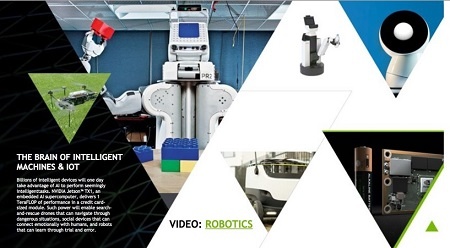
When I say, “early adopters of artificial intelligence (AI),” what do you see? Big shiny robots on a manufacturer’s assembly line? Smart grids diverting energy resources automatically to prevent blackouts? Autonomous cars “driving” down the highway?
AI Leaves Home
In reality, it’s mostly consumer AI applications that have visibly revolutionized our home and our mobile experiences in recent years. But manufacturers, energy providers, and transportation services are also starting to unlock trillions of dollars in industrial value through increased efficiency, higher productivity, enhanced quality of goods, and improved infrastructure.
According to Jerry Chen, Business Development for Industrial AI Applications at NVIDIA, “For years, people have used a variety of mathematical and numerical methods to build industrial automation solutions. But these traditional approaches typically weren’t robust, and they also needed lots of manual feature engineering to be effective. Imagine how great it would be if there was a method that was not only capable of automatically learning the most important features that best describe the data, but also achieved better accuracy and robustness than traditional methods? Sounds too good to be true—but that’s exactly what deep learning has proven capable of doing in recent years across multiple applications and multiple data types.”
Preparing for the Storm of Global Industrial Volatility
A steady stream of headlines this year are giving industrial executives plenty of reasons to lose sleep. Politically broken trade agreements, economic uncertainty, dwindling natural resources, unpredictable natural events, stricter regulations, and evolving workforce skills—in an environment with these woes, businesses can start to address some of these challenges with experienced human workers assisted by the best AI tools.
“Every year, the research in AI and deep learning is moving faster and faster—and businesses are innovating with a Cambrian explosion of neural network architectures,” observed Chen. “For industrial systems, the impact of this technology, especially as it continues to mature, can be game-changing. But the pace of innovation requires not only just a powerful parallel HPC [High Performance Computing] architecture, but also an extremely flexible general programming model to make it useful.”
Where Deep Learning is Catching On
And it seems that some industrial businesses are beginning to catch on. For example, GE subsidiary Baker Hughes is using AI to help the oil and gas industry optimize operational efficiency and perform preventative maintenance at remote sites and offshore platforms. By embracing a combination of AI-enabling graphics processing unit (GPU) technologies and data-center powerhouses, the company is processing deep learning both locally and, where possible, in the cloud.

Other uses for deep learning capabilities in industrial settings include:
- Factory inspections: Businesses can improve how new products are produced on a factory line. Deep learning capabilities can make quality inspections more precise to detect faults earlier and automate inventory classification.
- Field inspection: Monitoring the condition of infrastructure in the field is critical to environmental and human safety, as well as profitability. Businesses can apply AI to predict the remaining useful life of assets and plan the optimal time to engage in preventative maintenance.
- Predictive maintenance: Sophisticated AI algorithms do a better job of detecting and avoiding equipment failure while predicting the asset’s remaining useful life. Analysis of sensor-generated time-series data can be useful to defend operations against lagging operations and disruption.
Shaping the Future Through Learned Insight
Some businesses may choose to wait and see where deep learning takes their competitors, but such a conservative approach could prove to be catastrophic down the road. As Chen mentioned, “the evolution of AI is not slowing down anytime soon, and waiting will only make it more difficult to catch up in the face of a highly disruptive and volatile marketplace.”
This second wave of AI may be technologically different from the first one, but one fundamental reality remains the same: Industrial businesses are racing each other to inject increasing levels of automation and intelligence into their business processes. They will not only discover entirely new ways to deliver products and services better, cheaper, and faster than ever before, but they will also build a powerful resource of learned insight that will challenge every competitor well into the future.
Learn how to tap into the latest innovations in artificial intelligence. Register for our webcast, Industrial AI for Intelligent Enterprise to hear insights from Jerry Chen, Business Development in Machine Learning and Data Science at NVIDIA.